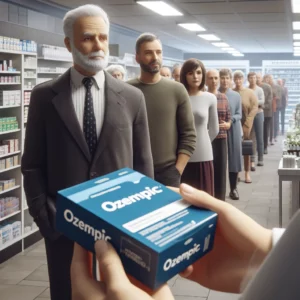The Devastating Impact of America’s Opioid Epidemic
The United States is grappling with an unprecedented drug epidemic, with fentanyl overdoses at the forefront of this crisis. As families across the nation mourn the loss of loved ones, the urgency for awareness and action has never been greater. The opioid crisis, particularly the surge in fentanyl-related deaths, has reached alarming proportions, affecting communities of all sizes and demographics. This epidemic not only claims lives but also strains healthcare systems, law enforcement resources, and the fabric of society itself.
5 Key Points
- Over 105,000 overdose deaths occurred in the 12 months ending February 2023
- Fentanyl is considered the deadliest of synthetic drugs, often mixed with other substances
- 98% of the world’s fentanyl supply reportedly comes from China
- An average of 22 adolescents aged 14-18 die weekly from drug overdoses in the US
- Fentanyl is involved in more deaths of Americans under 50 than any other cause
A Day of Remembrance and Awareness
The third annual Fentanyl Prevention and Awareness Day brought the devastating reality of the opioid crisis into sharp focus. In New York’s Times Square, a powerful visual display captured the nation’s attention: a six-story high billboard projected images of young lives lost to fentanyl overdoses or poisoning. This stark representation served as a haunting reminder of the human cost behind the statistics, putting faces to the numbers that often desensitize us to the true impact of this crisis.
At Father Duffey Square, over 100 people gathered, many of them parents clutching photos of children they had lost to drug abuse. The somber atmosphere underscored the personal toll of this epidemic. These gatherings, replicated in cities across the country, serve multiple purposes: they offer a space for collective mourning, raise public awareness, and demand action from policymakers and healthcare providers. The shared grief of these families creates a powerful narrative that cuts through the noise of daily news cycles, forcing society to confront the harsh realities of addiction and the deadly consequences of fentanyl.
The Scope of the Crisis
Frank Tarantino, Special Agent in charge of the Drug Enforcement Agency in New York, emphasized the gravity of the situation: “This is not a war on drugs; this is a fight to save lives.” This shift in perspective from criminalization to a public health crisis is crucial in addressing the epidemic effectively. The statistics paint a grim picture. According to James Puerta, co-chair of the nonprofit group “Facing Fentanyl,” the United States is experiencing “a 9/11 event every two weeks” in terms of lives lost.
This comparison to one of the nation’s most traumatic events underscores the scale of the crisis. The fentanyl epidemic is not just a series of individual tragedies; it’s a national emergency that affects public health, law enforcement, and social services. The rapid increase in overdose deaths has overwhelmed emergency responders and treatment facilities, creating a ripple effect that touches every aspect of society.
The nature of fentanyl itself further complicates the crisis. As a synthetic opioid, it’s relatively cheap to produce and easy to transport, making it attractive to drug traffickers. Its potency – 50 to 100 times stronger than morphine – means that even tiny amounts can be lethal. This potency also makes it dangerous for first responders and law enforcement officers who might accidentally come into contact with the drug during their duties.
Personal Stories of Loss
Behind every statistic is a personal tragedy. Michelle Stadick shared the heartbreak of losing her 21-year-old son, Riley, to a fentanyl overdose. “He was my hero. He was a great kid. I admired him,” she said, adding, “When a child dies, it changes your life forever.” Riley’s story is not just about the loss of a young life; it’s about the shattered dreams, the birthdays that will never be celebrated, and the future that was stolen not just from Riley but from his entire family.
Kamal Bherwani’s son Ethan was just 22 when he succumbed to fentanyl poisoning. “He had no idea he was taking fentanyl. He was out celebrating his graduation with friends, and he never came back home,” Bherwani recounted. Ethan’s story highlights a particularly insidious aspect of the fentanyl crisis – many victims are people with an addiction or regular drug users, but rather individuals who unknowingly ingest the substance mixed with other drugs. This reality has changed the face of the opioid epidemic, making it a threat not just to those struggling with addiction but to anyone who might experiment with drugs even once.
Sheila Mullins, whose 34-year-old son Nathaniel died a year ago, emphasized the indiscriminate nature of the crisis: “It could hit anybody.” Nathaniel’s story serves as a reminder that addiction and drug-related deaths are not confined to any particular demographic. The fentanyl crisis crosses all socioeconomic boundaries, affecting families from all walks of life. This universality of the threat has been a wake-up call for many communities that previously thought they were immune to such problems.
These personal narratives do more than humanize the statistics; they challenge societal perceptions about drug use and addiction. They force us to confront our biases and recognize that the victims of this crisis are not faceless strangers but sons, daughters, friends, and neighbors. Each story of loss represents a family forever altered, a community diminished, and a future unrealized.
The Deadliest Drug in America
Fentanyl’s impact on American society is staggering. Data shows that it has become the leading cause of death for Americans under 50, surpassing heart disease, cancer, and other illnesses. This statistic is particularly alarming when considering the preventable nature of these deaths. Unlike many other leading causes of death, fentanyl overdoses often claim young lives, resulting in decades of potential life loss.
The drug’s potency and its frequent, undisclosed mixture with other substances make it particularly dangerous. Fentanyl is often used to cut other drugs like heroin, cocaine, or counterfeit prescription pills, significantly increasing their potency. Users, unaware of this addition, can easily overdose on what they believe to be their usual dose of another drug. This unpredictability has turned recreational drug use into a game of Russian roulette, where every use could potentially be fatal.
The prevalence of fentanyl has also changed the landscape of addiction treatment. Traditional approaches to opioid addiction, such as methadone clinics or gradually decreasing dosages, may not be sufficient to combat fentanyl addiction. The drug’s potency often requires more intensive medical intervention during withdrawal, and the risk of relapse is higher due to the intensity of fentanyl’s effects.
Moreover, the rise of fentanyl has necessitated changes in harm-reduction strategies. Naloxone, a medication used to reverse opioid overdoses, often requires multiple doses to be effective against fentanyl overdoses. This has led to increased costs for emergency services and a need for broader distribution of naloxone to at-risk populations.
A Call to Action
The message from Fentanyl Prevention and Awareness Day is clear and urgent: one pill can kill. As law enforcement agencies work to curb the influx of fentanyl, primarily from China, the focus remains on education and prevention. However, addressing this crisis requires a multi-faceted approach that goes beyond traditional drug enforcement methods.
Education plays a crucial role in prevention. Schools, community organizations, and healthcare providers must work together to provide accurate, non-judgmental information about the risks of fentanyl and other opioids. This education needs to target not just potential users but also their families and communities, creating a network of informed individuals who can recognize the signs of addiction and respond to overdoses.
Prevention efforts must also address the root causes of drug use, including mental health issues, poverty, and lack of opportunity. Comprehensive programs that offer mental health support, job training, and community resources can help reduce the vulnerability of at-risk populations to drug addiction.
Treatment for those already struggling with addiction is another crucial component. Expanding access to medication-assisted treatment, increasing the number of treatment facilities, and providing long-term recovery support are all necessary steps. The stigma surrounding addiction must also be addressed, as it often prevents individuals from seeking help.
Policy changes are also needed to combat this crisis effectively. This may include stricter regulations on pharmaceutical companies, increased funding for addiction research and treatment, and reforms in the criminal justice system to prioritize treatment over incarceration for drug offenses.
The stories shared by grieving parents serve as a powerful reminder of the human cost of this crisis. They underscore the need for continued efforts in drug education, addiction treatment, and support for affected families. These personal accounts can be powerful advocacy tools, helping shape public opinion and influence policy decisions.
As the fentanyl crisis continues to evolve, so too must our responses. Innovative approaches, such as the use of technology to detect fentanyl in drug supplies or the development of more effective overdose reversal medications, will be crucial in saving lives. Collaboration between healthcare providers, law enforcement, policymakers, and community organizations is essential to create comprehensive, effective strategies to combat this epidemic.
The fentanyl crisis is not just a public health emergency; it’s a societal challenge that requires the engagement of every community member. By raising awareness, supporting affected families, and demanding action from our leaders, we can work towards a future where the tragedy of fentanyl overdoses becomes a thing of the past.
FAQ
Q: What is fentanyl?
A: Fentanyl is a synthetic opioid that is 50-100 times more potent than morphine. It’s often mixed with other drugs without users’ knowledge, significantly increasing the risk of overdose.
Q: How many overdose deaths occurred in the US recently?
A: According to the Centers for Disease Control, there were over 105,000 overdose deaths in the 12-month period that ended in February 2023.
Q: What age group is most affected by fentanyl overdoses?
A: While fentanyl affects all age groups, it’s particularly deadly for Americans under 50. An average of 22 adolescents aged 14-18 die weekly from drug overdoses in the US.
Q: Where does most of the world’s fentanyl come from?
A: Reports indicate that 98% of the world’s fentanyl supply comes from China.
Q: What is the main message of Fentanyl Prevention and Awareness Day?
A: The primary message is that “one pill can kill,” emphasizing the extreme danger of fentanyl and the importance of prevention and awareness.
Citations:
Scott, M. (2024, August 22). Parents share heartbreak of losing children from fentanyl overdoses. MSN. https://www.msn.com/en-us/health/other/parents-share-heartbreak-of-losing-children-from-fentanyl-overdoses/ar-AA1pddU2







